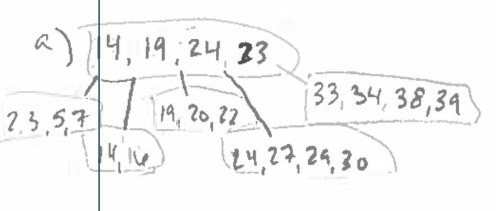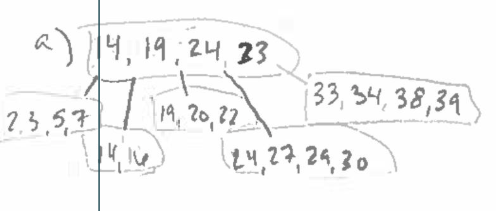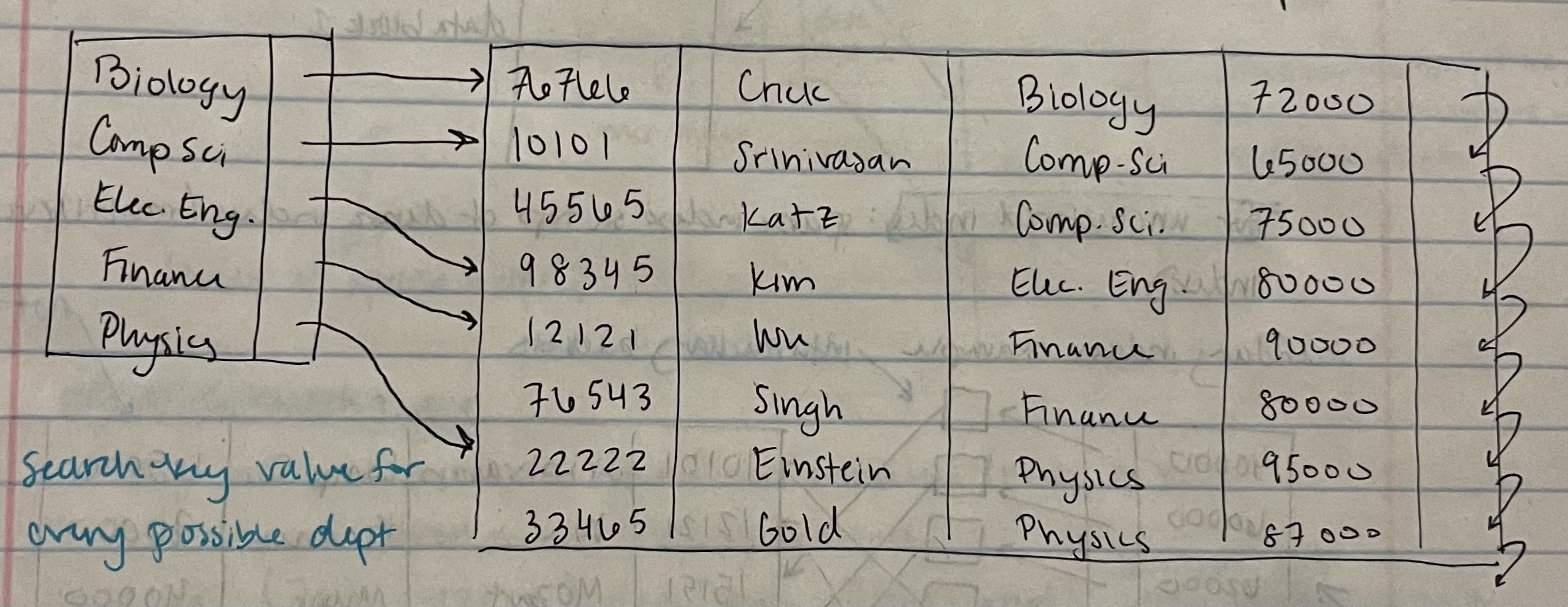Indexing (Ch. 9)
1/30
Earn XP
Description and Tags
Chapter 9
Name | Mastery | Learn | Test | Matching | Spaced |
|---|
No study sessions yet.
31 Terms

Given this B+ tree where N=5, show the tree after inserting 30.


Given this B+ tree where N=5, show the tree after deleting 14.


Given this B+ tree where N=5, show the tree after inserting 4.

access types
access time
insertion time
deletion time
space overhead
When creating an index, what are the 5 evaluation metrics we used to determine if the index is ‘good’?
the ordering of the file
Which does the primary index determine when using an ordered index?
yes
In a B+ tree, is the length of the path from the root to any leaf the same?
between ceiling(N/2) and N children
In a B+ tree, an internal node that is not a leaf or the root must have how many children?
sparse index
Which type of index does not require every search-key to appear?
ceiling((N-1)/2) and N-1 values
In a B+ tree, a leaf node that is not the root must have how many values?
bulk loading
What is the process of adding a large number of entries to a B+ tree at one time?
index on A.dogId
Given the following query:
SELECT D.name, D.age FROM dog D, appt A WHERE A.dogId=D.dogId AND A.time=0800;
Which of the following indices could be useful for the query:
index D.name
index on A.dogId
index on D.age
B+ Tree index
Given the following query:
SELECT D.name, D.age FROM dog D, appt A WHERE A.dogId=D.dogId AND D.age>100;
Which of the following indices could be useful for the query for D.age?
both B+ Tree and Hash
B+ Tree index
neither B+ Tree or Hash
Hash index
ordered indices and hash indices
What are the two main types of indices?
in a sequentially ordered file, the index whose search key specifies the sequential order of the file
What is a clustering (primary) index?
an index whose search key specifies an order different from the sequential order of the file
What is the non-clustering (secondary) index?
a sequential file ordered on a search key, with a clustering index on the search key
What is an index-sequential file?

when an index appears for every search-key value in the file
What is a dense index?

when a file contains index records for only some search-key values
What is a sparse index?
a sparse index with an index entry for every block in the file, corresponding to last search-key value in the block
What is a good tradeoff for clustered indices?
a sparse index on top of dense index/multilevel index
What is a good trade-off for unclustered indices?
dense
Are secondary indices dense or sparse?
secondary indices
Which type of indices use buckets that contain pointers to all the records?
at least 2
If the root of a B+ tree is not a leaf, how many children must it have?
between 0 and N-1
if the root of a B+ Tree is a leaf, how many values can it have?
a query that finds all records with search-key values in a given range
Define range queries.
ceiling(logceiling(N/2)(k))
If there are k search-key values in a file, what is the max height of the tree?
Find the leaf node in which the search-key value would appear
If there is room in the leaf node, insert the pointer/value pair into the leaf node
Otherwise, split the node
List the steps to insert a new value in a B+ Tree.
Take the n (search-key value pointer) pairs (including the one being inserted) in sorted order
Place the first ceiling(N/2) in the original node, and the rest in a new node
Let the new node be p, and let k be the least key value in p. Insert (k,p) in the parent of the node being split
If the parent is full, split it and propagate the split further up
List the steps to split a leaf node when inserting a value.
Remove the pointer/value pair from the leaf node
If the node has too few entries, then merge siblings if enough room
insert all values in the 2 nodes into a single node (left) and delete other node
delete the pointer/value pair (ki-1, pi), where pi is the pointer to the deleted node, from the parent node, recursively using above procedure
Otherwise, redistribute pointers
redistribute between node and a sibling such that both have more than the minimum number of entries
update corresponding search-key values in parent
List the steps to delete a value from a leaf node in a B+ Tree.
the root is deleted and the sole child becomes the root
What happens if a root has only one pointer after deletion?
merge left
merge right
borrow left
borrow right
When deleting a node from a B+ tree, what are the 4 options in order?